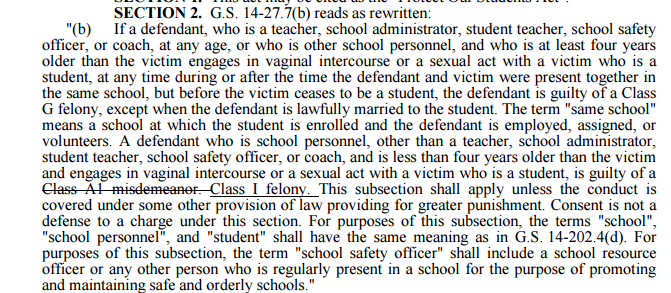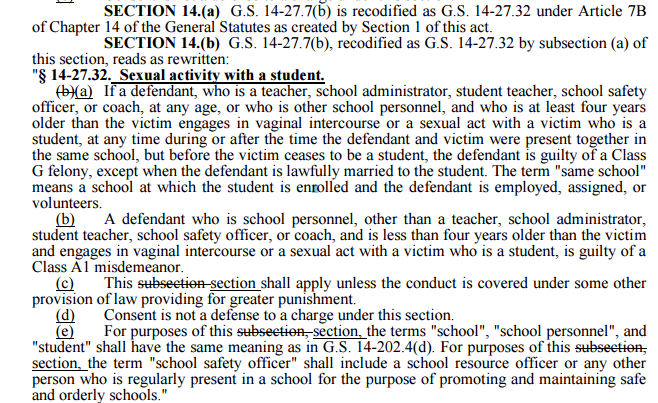
How is a statute supposed to read when the General Assembly amends it in May and then amends it again in July without acknowledging the prior amendment? Let me clarify with an example.
In May 2015, S.L. 2015-44 was ratified; it was signed by the Governor in June. That Session Law amended G.S. 14-27.7(b), sexual activity with a student, elevating from a misdemeanor to a felony the version of this offense that occurs when the defendant qualifies as school personnel other than a teacher, etc. and is less than four years older than the victim as follows:
Then in July 2015, S.L. 2015-181 was ratified; it was signed by the Governor in August. This session law re-codified G.S. 14-27.7(b) as G.S. 14-27.32 and broke it into subsections. But the recodified statute, as set out in this Session Law didn’t incorporate the prior punishment increase. S.L. 2015-181 set out the recodified statute as follows:
So the question is: What is the punishment for sexual activity with a student by a defendant who is less than four years older than the victim? Is it as a Class A1 misdemeanor as reflected in the later Session Law? Or does the elevation to a felony in the earlier Session Law apply? It’s a head scratcher isn’t it? Fortunately I had an easy path to an answer: I called my former mentor and colleague Bob Farb. Notwithstanding the fact that I probably caught him poolside in sunny Florida enjoying his retirement, Bob pointed me to the answer: G.S. 120-20.1 (coded bill drafting). That statute, provides, in relevant part: “In any part of a law enacted in the format provided by this section [with strikethroughs for deleted language and underlining for added language], the material deleted from existing law and the material being added to existing law are the only changes made, the setting out of material not deleted or added is for illustration only, and the fact that two different acts amend the same law, when one or more of those is in the format provided by this section, does not in itself create a conflict.” Applying this rule, only the underlined and struck through language in the later Session Law is binding; the rest of the language is illustrative only. Thus, the punishment enhancement of the earlier statute applies.
I once saw a student evaluation that referred to Bob as the “The Oracle of Chapel Hill.” He may be retired in Florida but the title still holds.


